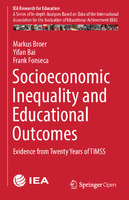Socioeconomic Inequality and Educational Outcomes
Evidence from Twenty Years of TIMSS
| dc.contributor.author | Broer, Markus | |
| dc.contributor.author | Bai, Yifan | |
| dc.contributor.author | Fonseca, Frank | |
| dc.date.accessioned | 2020-03-18 13:36:15 | |
| dc.date.accessioned | 2020-04-01T08:57:44Z | |
| dc.date.available | 2020-04-01T08:57:44Z | |
| dc.date.issued | 2019 | |
| dc.identifier | 1007202 | |
| dc.identifier | OCN: 1103473808 | |
| dc.identifier.uri | http://library.oapen.org/handle/20.500.12657/22958 | |
| dc.description.abstract | This open access book focuses on trends in educational inequality using twenty years of grade 8 student data collected from 13 education systems by the IEA’s Trends in Mathematics and Science Study (TIMSS) between 1995 and 2015. While the overall positive association between family socioeconomic status (SES) and student achievement is well documented in the literature, the magnitude of this relationship is contingent on social contexts and is expected to vary by education system. Research on how such associations differ across societies and how the strength of these relationships has changed over time is limited. This study, therefore, addresses an important research and policy question by examining changes in the inequality of educational outcomes due to SES over this 20-year period, and also examines the extent to which the performance of students from disadvantaged backgrounds has improved over time in each education system. Education systems generally aim to narrow the achievement gap between low- and high-SES students and to improve the performance of disadvantaged students. However, the lack of quantifiable and comprehensible measures makes it difficult to assess and monitor the effect of such efforts. In this study, a novel measure of SES that is consistent across all TIMSS cycles allows students to be categorized into different socioeconomic groups. This measure of SES may also contribute to future research using TIMSS trend data. Readers will gain new insight into how educational inequality has changed in the education systems studied and how such change may relate to the more complex picture of macroeconomic changes in those societies. | |
| dc.language | English | |
| dc.relation.ispartofseries | IEA Research for Education | |
| dc.subject.classification | thema EDItEUR::J Society and Social Sciences::JB Society and culture: general::JBF Social and ethical issues | en_US |
| dc.subject.classification | thema EDItEUR::J Society and Social Sciences::JH Sociology and anthropology::JHB Sociology | en_US |
| dc.subject.classification | thema EDItEUR::J Society and Social Sciences::JH Sociology and anthropology::JHB Sociology::JHBC Social research and statistics | en_US |
| dc.subject.classification | thema EDItEUR::J Society and Social Sciences::JN Education | en_US |
| dc.subject.classification | thema EDItEUR::J Society and Social Sciences::JN Education::JND Educational systems and structures::JNDH Education: examinations and assessment | en_US |
| dc.subject.other | Education | |
| dc.subject.other | International education | |
| dc.subject.other | Comparative education | |
| dc.subject.other | Educational sociology | |
| dc.subject.other | Education and sociology | |
| dc.subject.other | Statistics | |
| dc.subject.other | Assessment | |
| dc.subject.other | Social structure | |
| dc.subject.other | Social inequality | |
| dc.title | Socioeconomic Inequality and Educational Outcomes | |
| dc.title.alternative | Evidence from Twenty Years of TIMSS | |
| dc.type | book | |
| oapen.identifier.doi | 10.1007/978-3-030-11991-1 | |
| oapen.relation.isPublishedBy | 6c6992af-b843-4f46-859c-f6e9998e40d5 | |
| oapen.pages | 83 | |
| oapen.place.publication | Cham |

